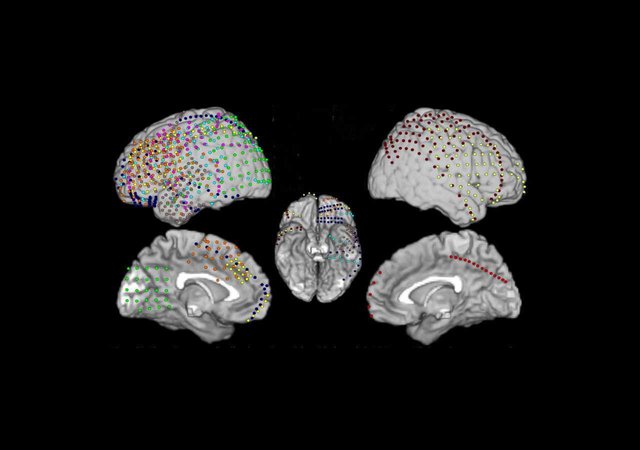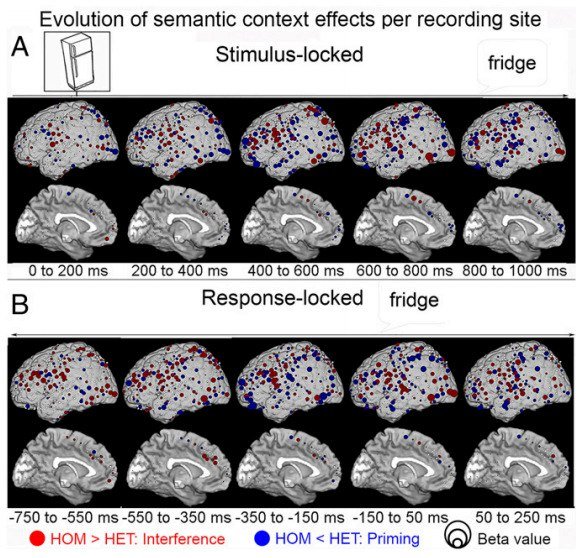The neural mechanism of speech formation was decomposed into milliseconds
An international team of scientists has discovered that the neural correlate of a contextually homogeneous and heterogeneous verbal response intersects in time.
Normally, the speed of a smooth speech of an adult person is two or three words per second, which are extracted from a mental lexicon with a volume of about 100,000 words. The ability to such a systematization determines the quality of verbal communication, and its relevance is confirmed by cases of aphasia. However, the neural correlate of speech production remains unclear. Usually, its study involves the presentation of a series of related and unrelated images to the subjects: according to one of the hypotheses, the first accelerate the activation of specific zones of the brain due to semantic interference. Meanwhile, a series of experiments (1, 2) revealed an opposite trend - in favor of semantic priming.
The areas of the brain associated with speech formation include the lower frontal gyrus (IFG), the medial zones of the pre-SMA and the anterior cingulate cortex, the middle (MTG) and lower (ITG) temporal gyrus. In addition to reliable results, past studies of lexical semantics did not provide for an assessment of the space-time parameters of these structures. To fill the gap, staff at the University of California at San Diego and other institutions conducted an experiment with nine patients who were preparing for the surgical treatment of epilepsy. At this stage, their brain activity was recorded with the help of intracranial electrodes.
As a rule, this method (electrocorticography, ECOG) is used in experiments on wild animals. In the case of subjects, it was used to search for an epileptic focus for the purpose of subsequent removal. Thus, the preparation of patients allowed the authors to measure the word extraction speed with millisecond time resolution. Scientists focused on high-frequency activity (70-150 hertz) of the brain - according to previous work, it comparatively accurately reflects the indicator when performing language tests. Activity was recorded when four categories of items were presented (clothing, animals, musical instruments, everyday life), which participants had to quickly name.
Brain activity corresponding to the selection of the word "refrigerator" (A) and its verbalization (B). The red color indicates areas that are more active in response to homogeneous concepts (semantic interference dominates the semantic priming), blue in response to heterogeneous concepts (priming dominates interference) / Stephanie K. Rièsa et al., PNAS, 2017
The results showed that pattern recognition and word extraction occurred almost simultaneously and involved a wider brain network than previously thought. Thus, approximately 400-600 milliseconds after the stimulus was presented, semantic interference appeared in the lower temporal and frontal gyrus. Then, the activation of these zones increased, accompanied (by mixing unconnected concepts) by increasing potentials in the lateral preexternal and medial prefrontal cortex. According to scientists, the latter is probably responsible for resolving semantic contradictions, whereas ITG is first involved in finding the right word.
Given the activation time (350 milliseconds before and within 250 milliseconds after the scoring of the answer), the primordial cortex, in turn, can play the role of a speech modulator, the authors believe. It is also noteworthy that pre-SMA damage in one of the patients led to a significant (by more than 40 percentage points) delay in response time. These data are consistent with the results of some past experiments (1, 2). Activation of the remaining brain structures occurred 600-800 milliseconds after the image was shown. The researchers note that clarifying the neuronal correlate of speech production can help in developing new methods of treating speech disorders.
The article is published in the journal Proceedings of the National Academy of Sciences.
Hi, this looks cool. Do you have a link?
Unfortunately the source is unknown.
Ok thanks, it looks like http://m.pnas.org/content/114/23/E4530.abstract but it's behind a pay wall